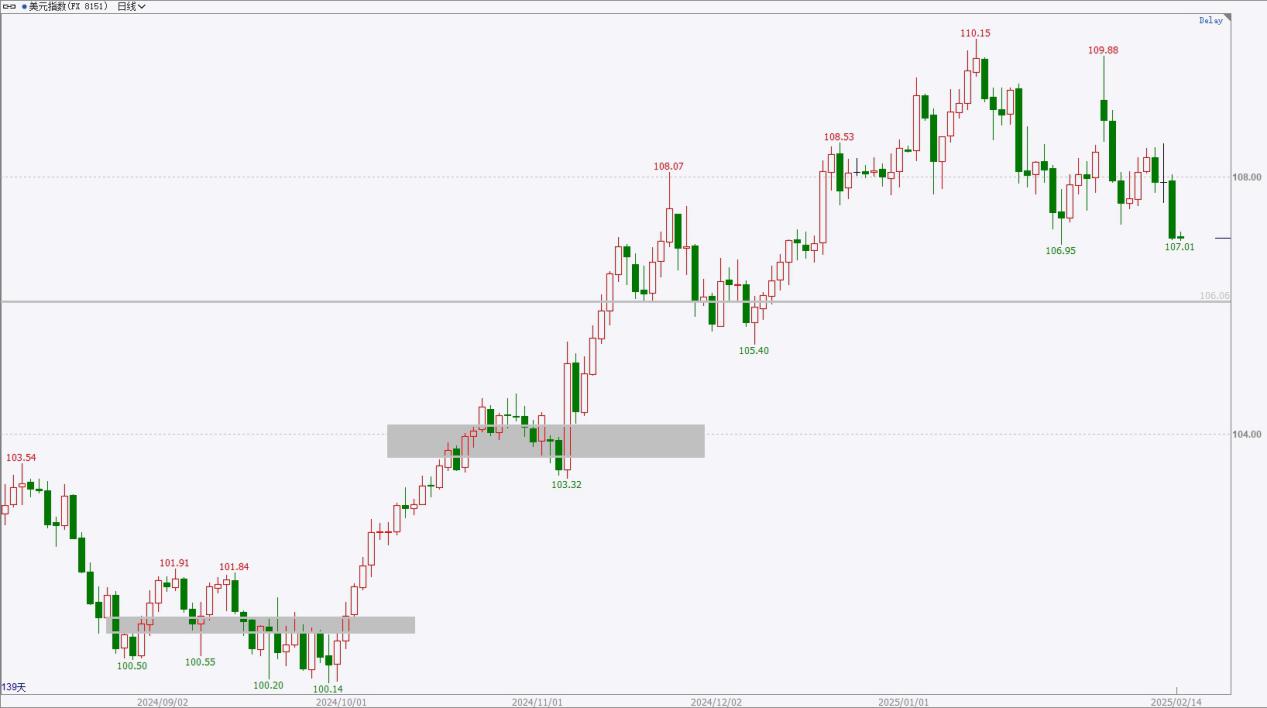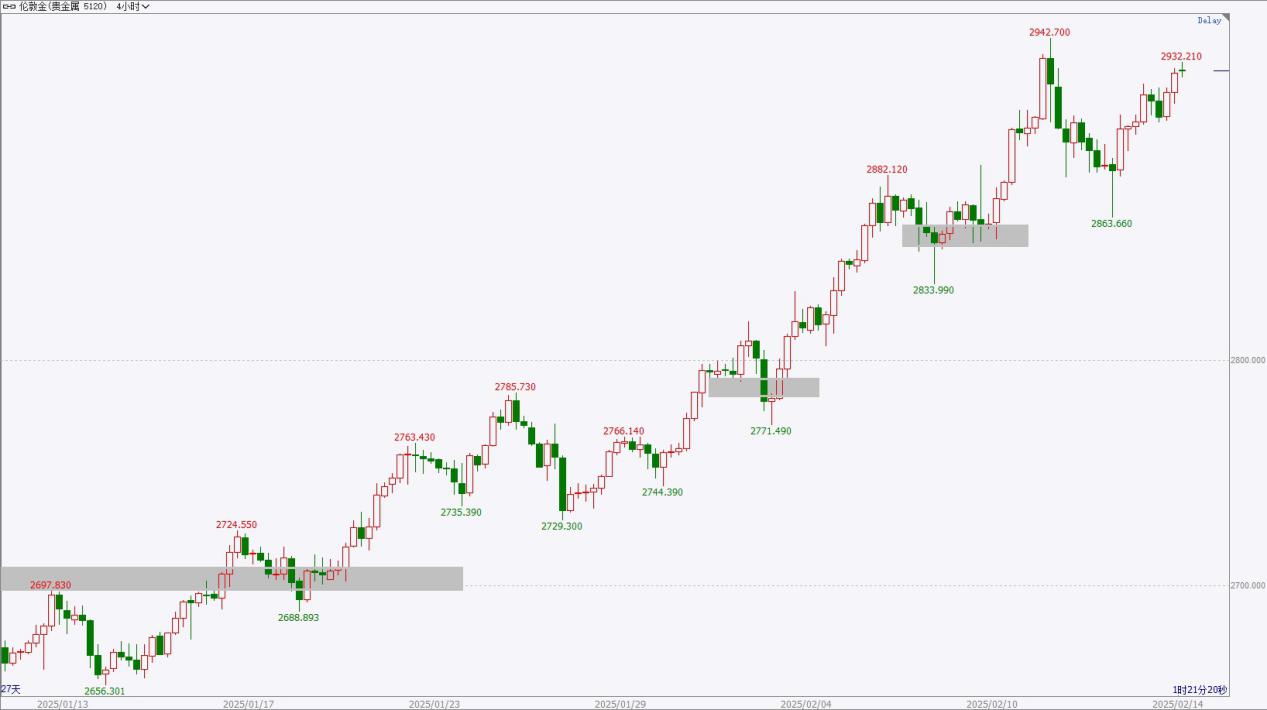|
Time
|
Data and Events
|
Importance
|
|
18:00
|
Eurozone Q4 GDP year-on-year revision
|
★★★
|
|
Eurozone Q4 seasonally adjusted employment change final value
|
★★★
|
|
21:30
|
Canada December wholesale sales month-on-month
|
★★★
|
|
US January retail sales month-on-month
|
★★★★
|
|
US January import price index month-on-month
|
★★★
|
|
22:15
|
US January industrial production month-on-month
|
★★★
|
|
23:00
|
US December business inventories month-on-month
|
★★★
|
|
Variety
|
Perspective
|
Support Zone
|
Resistance Zone
|
|
US Dollar Index
|
High volatility
|
107-107.5
|
110-111
|
|
Gold
|
Slightly strong volatility
|
2850-2870
|
2980-3000
|
|
Crude Oil
|
Short-term volatility
|
69-70
|
79-80
|
|
Euro
|
Short-term volatility
|
1.0180-1.0200
|
1.0500-1.0550
|
*The viewpoints before the market are time-sensitive and limited, belonging to predictions, for reference and learning only, do not constitute investment advice, and operation risks are borne by yourself. Investment has risks; trading requires caution.
Fundamental Analysis:
At the end of January, the Federal Reserve meeting maintained interest rates unchanged, the labor market remains strong, economic activity is steadily expanding, and inflation levels are still slightly high. Expectations for monetary policy easing have cooled, and attention will be paid to new government policies. January non-farm data showed new jobs decreased to 143,000, lower than expected, while the unemployment rate slightly fell to 4.0%, demonstrating a robust labor market. The January unadjusted CPI year-on-year recorded 3.0%, slightly higher than previous values and expectations. The December core PCE price index remained flat with previous values; the January ISM manufacturing PMI slightly increased.
Technical Analysis:

The US Dollar Index fell sharply yesterday, with weak performance in the short cycle. The current support area may show signs of breaking, and if it clearly breaks the structure, the trend may weaken further. In the short term, a reversal selling strategy can be tried. Overall, there is a strong likelihood of major oscillation with adjustments entering soon. The important resistance zone above is near 110-111, and the support zone below is around 107-107.5.
Opinion: High volatility with signs of breaking in the support area; a short-selling strategy can be tried in the short term.
*The viewpoints before the market are time-sensitive and limited, belonging to predictions, for reference and learning only, do not constitute investment advice, and operation risks are borne by yourself. Investment has risks; trading requires caution.
Fundamental Analysis:
The ongoing deterioration of geopolitical conflicts in the Middle East and the volatile situation in Eastern Europe introduces uncertainties. The ECB’s interest rate decision at the end of January saw a continuous fourth rate cut of 25 basis points, with inflation broadly meeting expectations but economic performance remaining weak and under pressure. The Fed’s interest rate decision at the end of January kept rates unchanged, showing good economic activity, but inflation levels are still high, and the expectations for rate cuts have eased. January’s non-farm data performed moderately, with new job growth decreasing and slightly better-than-expected unemployment rate; the January CPI year-on-year slightly warmed, marginally exceeding expectations.
Technical Analysis:

Gold prices continued their upward trend yesterday, with short cycles showing upward oscillation near previous high resistance levels. Long positions can be reduced at highs for profit, with the short-term performance still relatively strong, focusing on whether prices can reach new highs. From a broader perspective, the upward structure remains intact, with a daily oscillation moving upward and prices frequently reaching new highs. The upper pressure level could be near 2980-3000, while the lower minor support level may be around 2850-2870.
Opinion: Slightly strong volatility; a short-term long strategy is preferred, and reducing long positions for profit at highs is advised.
*The viewpoints before the market are time-sensitive and limited, belonging to predictions, for reference and learning only, do not constitute investment advice, and operation risks are borne by yourself. Investment has risks; trading requires caution.
Fundamental Analysis:
In the February EIA monthly report, the global oil demand growth forecast for this year and next year is maintained, with a slight adjustment to the 2025 oil price; the OPEC monthly report also maintains the global oil demand growth forecast for this year and next year; the IEA monthly report slightly raises the global oil demand growth forecast for 2025. At the beginning of February, an OPEC+ meeting decided to adhere to the previous oil production agreement, and the committee agreed to gradually increase oil production starting from April 1, in line with earlier plans. EIA crude oil inventories have increased substantially, and this data has fluctuated significantly recently.
Technical Analysis:

U.S. crude oil rebounded slightly yesterday, with prices testing an important support area for the second time without a significant breakout downward. In the short term, it may continue to fluctuate, so pay attention to signs of stabilization, at which point there might be opportunities to buy on dips. Overall, crude oil prices are showing a strong tendency to fluctuate, with signs of stabilization on a larger scale, and a short-term correction is anticipated. The upper pressure area is around 79-80, while the lower support area is around 69-70.
Viewpoint: Short-term fluctuations near the support area, look for signs of stabilization to attempt buying on dips.
*The viewpoints before the market are time-sensitive and limited, belonging to predictions, for reference and learning only, do not constitute investment advice, and operation risks are borne by yourself. Investment has risks; trading requires caution.
Fundamental Analysis:
The Eurozone Central Bank’s interest rate decision at the end of January saw a fourth consecutive rate cut of 25 basis points, with inflation basically in line with expectations, expecting to return to mid-term targets this year. The economy still faces challenges and may continue to show weakness in the short term, but income and policy effects support a rebound in demand. In late January, the U.S. Federal Reserve decided to keep interest rates unchanged, with overall economic performance being strong and easing expectations subsiding. The U.S. January non-farm payroll report was somewhat disappointing, with job growth less than expected and a slight decrease in the unemployment rate, which was slightly better than anticipated; the U.S. January CPI year-on-year increased slightly, slightly higher than expected.
Technical Analysis:

The euro continued to rise yesterday, showing an upward trend in the short cycle, with a short-term performance leaning toward strength and potentially having more room for growth. Attention should be paid to the pressure area above, as a breakout in this structure may lead to a stronger trend. Overall, the price is at a relatively low level, with a daily fluctuation structure that has not yet shown significant stabilization signals on a larger scale. The upper small pressure area is around 1.0500-1.0550, while the lower support area is around 1.0180-1.0200.
Viewpoint: Short-term fluctuations, pay attention to whether the pressure structure can break through, and consider attempting to buy on dips.
*The viewpoints before the market are time-sensitive and limited, belonging to predictions, for reference and learning only, do not constitute investment advice, and operation risks are borne by yourself. Investment has risks; trading requires caution.


Daily Reviews
Our award-winning team of analysts provides keen and insightful technical and fundamental analysis to understand daily market news and investment trading opportunities
HTFX Daily Forex Commentary 0214
Time
Data and Events
Importance
18:00
Eurozone Q4 GDP year-on-year revision
★★★
Eurozone Q4 seasonally adjusted employment change final value
★★★
21:30
Canada December wholesale sales month-on-month
★★★
US January retail sales month-on-month
★★★★
US January import price index month-on-month
★★★
22:15
US January industrial production month-on-month
★★★
23:00
US December business inventories month-on-month
★★★
Variety
Perspective
Support Zone
Resistance Zone
US Dollar Index
High volatility
107-107.5
110-111
Gold
Slightly strong volatility
2850-2870
2980-3000
Crude Oil
Short-term volatility
69-70
79-80
Euro
Short-term volatility
1.0180-1.0200
1.0500-1.0550
*The viewpoints before the market are time-sensitive and limited, belonging to predictions, for reference and learning only, do not constitute investment advice, and operation risks are borne by yourself. Investment has risks; trading requires caution.
Fundamental Analysis:
At the end of January, the Federal Reserve meeting maintained interest rates unchanged, the labor market remains strong, economic activity is steadily expanding, and inflation levels are still slightly high. Expectations for monetary policy easing have cooled, and attention will be paid to new government policies. January non-farm data showed new jobs decreased to 143,000, lower than expected, while the unemployment rate slightly fell to 4.0%, demonstrating a robust labor market. The January unadjusted CPI year-on-year recorded 3.0%, slightly higher than previous values and expectations. The December core PCE price index remained flat with previous values; the January ISM manufacturing PMI slightly increased.
Technical Analysis:
The US Dollar Index fell sharply yesterday, with weak performance in the short cycle. The current support area may show signs of breaking, and if it clearly breaks the structure, the trend may weaken further. In the short term, a reversal selling strategy can be tried. Overall, there is a strong likelihood of major oscillation with adjustments entering soon. The important resistance zone above is near 110-111, and the support zone below is around 107-107.5.
Opinion: High volatility with signs of breaking in the support area; a short-selling strategy can be tried in the short term.
*The viewpoints before the market are time-sensitive and limited, belonging to predictions, for reference and learning only, do not constitute investment advice, and operation risks are borne by yourself. Investment has risks; trading requires caution.
Fundamental Analysis:
The ongoing deterioration of geopolitical conflicts in the Middle East and the volatile situation in Eastern Europe introduces uncertainties. The ECB’s interest rate decision at the end of January saw a continuous fourth rate cut of 25 basis points, with inflation broadly meeting expectations but economic performance remaining weak and under pressure. The Fed’s interest rate decision at the end of January kept rates unchanged, showing good economic activity, but inflation levels are still high, and the expectations for rate cuts have eased. January’s non-farm data performed moderately, with new job growth decreasing and slightly better-than-expected unemployment rate; the January CPI year-on-year slightly warmed, marginally exceeding expectations.
Technical Analysis:
Gold prices continued their upward trend yesterday, with short cycles showing upward oscillation near previous high resistance levels. Long positions can be reduced at highs for profit, with the short-term performance still relatively strong, focusing on whether prices can reach new highs. From a broader perspective, the upward structure remains intact, with a daily oscillation moving upward and prices frequently reaching new highs. The upper pressure level could be near 2980-3000, while the lower minor support level may be around 2850-2870.
Opinion: Slightly strong volatility; a short-term long strategy is preferred, and reducing long positions for profit at highs is advised.
*The viewpoints before the market are time-sensitive and limited, belonging to predictions, for reference and learning only, do not constitute investment advice, and operation risks are borne by yourself. Investment has risks; trading requires caution.
Fundamental Analysis:
In the February EIA monthly report, the global oil demand growth forecast for this year and next year is maintained, with a slight adjustment to the 2025 oil price; the OPEC monthly report also maintains the global oil demand growth forecast for this year and next year; the IEA monthly report slightly raises the global oil demand growth forecast for 2025. At the beginning of February, an OPEC+ meeting decided to adhere to the previous oil production agreement, and the committee agreed to gradually increase oil production starting from April 1, in line with earlier plans. EIA crude oil inventories have increased substantially, and this data has fluctuated significantly recently.
Technical Analysis:
U.S. crude oil rebounded slightly yesterday, with prices testing an important support area for the second time without a significant breakout downward. In the short term, it may continue to fluctuate, so pay attention to signs of stabilization, at which point there might be opportunities to buy on dips. Overall, crude oil prices are showing a strong tendency to fluctuate, with signs of stabilization on a larger scale, and a short-term correction is anticipated. The upper pressure area is around 79-80, while the lower support area is around 69-70.
Viewpoint: Short-term fluctuations near the support area, look for signs of stabilization to attempt buying on dips.
*The viewpoints before the market are time-sensitive and limited, belonging to predictions, for reference and learning only, do not constitute investment advice, and operation risks are borne by yourself. Investment has risks; trading requires caution.
Fundamental Analysis:
The Eurozone Central Bank’s interest rate decision at the end of January saw a fourth consecutive rate cut of 25 basis points, with inflation basically in line with expectations, expecting to return to mid-term targets this year. The economy still faces challenges and may continue to show weakness in the short term, but income and policy effects support a rebound in demand. In late January, the U.S. Federal Reserve decided to keep interest rates unchanged, with overall economic performance being strong and easing expectations subsiding. The U.S. January non-farm payroll report was somewhat disappointing, with job growth less than expected and a slight decrease in the unemployment rate, which was slightly better than anticipated; the U.S. January CPI year-on-year increased slightly, slightly higher than expected.
Technical Analysis:
The euro continued to rise yesterday, showing an upward trend in the short cycle, with a short-term performance leaning toward strength and potentially having more room for growth. Attention should be paid to the pressure area above, as a breakout in this structure may lead to a stronger trend. Overall, the price is at a relatively low level, with a daily fluctuation structure that has not yet shown significant stabilization signals on a larger scale. The upper small pressure area is around 1.0500-1.0550, while the lower support area is around 1.0180-1.0200.
Viewpoint: Short-term fluctuations, pay attention to whether the pressure structure can break through, and consider attempting to buy on dips.
*The viewpoints before the market are time-sensitive and limited, belonging to predictions, for reference and learning only, do not constitute investment advice, and operation risks are borne by yourself. Investment has risks; trading requires caution.
Latest Reviews
HTFX Daily Forex Commentary 0819
HTFX Daily Forex Commentary 0815
HTFX Daily Forex Commentary 0812
HTFX Daily Forex Commentary 0811
Choose a Trusted Broker for Trading
Over 300 employees worldwide, more than 1,000 products, top-tier liquidity